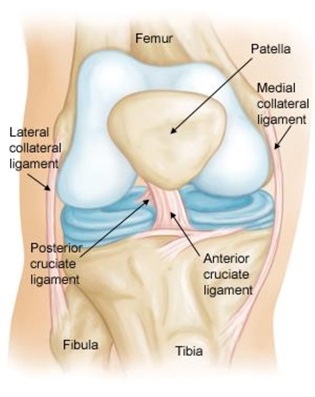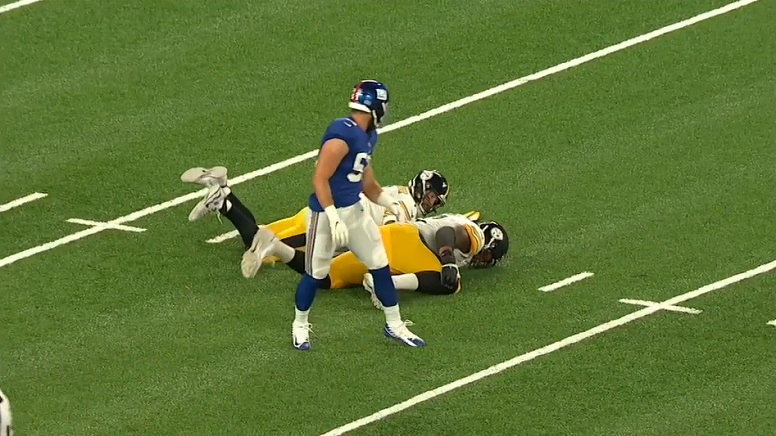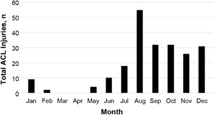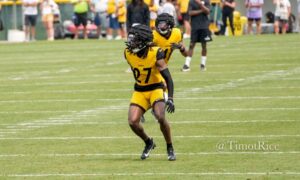I don’t want to say it and you don’t want to hear it, but there is a really good chance that our beloved new starting Right Tackle may be lost for the season. In the Monday Night Football season opener against the Giants, the Steelers lineman went down late in the game. He had to be helped off the field and was carted to the locker room.
In the post-game presser, Head Coach Mike Tomlin only described it as a knee injury. There is only one view available on video right now, so I’m speculating. But here’s why I think it could be an ACL tear:
- It appears the injury wasn’t due to direct contact. Banner’s right lower leg bent inward as he spun during his block but he wasn’t hit.
- Banner appeared devasted, knowing it was bad.
I’ll explain…
And for the usual disclaimer, I just going off what we all saw on TV and I have no definite knowledge of Banner’s medical situation.
First, a quick refresher course on ACL injuries, starting with the anatomy of the knee ligaments:

1 The anterior cruciate ligament runs diagonally in the middle of the knee. It prevents the tibia from sliding out in front of the femur, as well as provides rotational stability to the knee. 2 orthoinfo.aaos.org
Also courtesy of the American Academy of Orthopaedic Surgeons:
- Grade 1 Sprains.The ligament is mildly damaged in a Grade 1 Sprain. It has been slightly stretched, but is still able to help keep the knee joint stable.
- Grade 2 Sprains.A Grade 2 Sprain stretches the ligament to the point where it becomes loose. This is often referred to as a partial tear of the ligament.
- Grade 3 Sprains.This type of sprain is most commonly referred to as a complete tear of the ligament. The ligament has been split into two pieces, and the knee joint is unstable.
- Partial tears of the anterior cruciate ligament are rare; most ACL injuries are complete or near complete tears.
- About half of all injuries to the anterior cruciate ligament occur along with damage to other structures in the knee, such as articular cartilage, meniscus, or other ligaments.
About 70% of ACL injuries are “non-contact” injuries, meaning that there is no direct trauma to the knee. Instead, the ligament tear occurs due to pressure and torque based on the athlete’s movement. If you want to really geek out on the science, read this analysis, published in the Journal of the American Academy of Orthopaedic Surgerons. TL;DR? Here’s a quick summary from the AAOS website: “they occur primarily during deceleration of the lower extremity, with the quadriceps maximally contracted and the knee at or near full extension.”
A majority of ACL tears can accurately be diagnosed without an MRI. According to a 2001 study, If performed properly, a complete knee examination for ACL injury can be highly accurate, with a sensitivity and specificity of 82 and 94 percent. So I would guess that Dr. Bradley, the Steelers team doctor and an orthopaedic surgeon, already made a diagnosis and shared that with Zach. Or Zach just knew based on how it felt that it was serious.
To surgically repair the ACL and restore knee stability, the ligament cannot just be sewn back together – it has to be reconstructed. This is done with a graft which serves as a scaffold for the new ligament to heal onto. Different types of grafts are used, ranging from cadaver grafts to tissue from somewhere else in the leg: the patellar tendon, the hamstring tendon or the quadriceps tendon. In a 2012 survey of NFL and NCAA Division 1 team orthopaedic surgeons, 86% of them reported that they use patellar tendon reconstruction. Here is a brief video of a schematic of a basic ACL repair. For those interested, here is a video of an actual ACL repair from Dr. David Geier, a sports medicine specialist who is also a good follow on twitter (@DrDavidGeier).
So if Zach needs surgery, is the season a total loss for him? Without the previous limits on how many players can be designated IR/Return, you might wonder if he could work his way back to the roster if the Steelers make a playoff run. Let’s look at some data for ACL recovery times for NFL players to answer that question.
This isn’t as easy an answer as you might think because a lot of ACL injuries occur early in the season. Players who wind up on IR don’t usually come back until the following season, so it can look like a 12 month recovery for many of them. A study in the Orthopaedic Journal of Sports Medicine reviewed all ACL injuries in NFL players from 2010 to 2013. They found that a majority of ACL injuries occur in preseason:
This makes sense because there are many more players on the field (90 as compared to the regular season roster of 53). Based on this, most studies look at return to play as an NFL athlete playing the following season.
Everyone always talks about how miraculous Adrian Peterson’s recovery from his ACL injury was. He suffered the knee injury on Christmas Eve in the 2011 Week 16 win over the Redskins. He underwent repair of his ACL and MCL 6 days later. After obsessively working on his rehab in the offseason, he was ready to go Week 1 the following season. Peterson ended the 2012 season a mere 8 yards shy of the all-time rushing record set by Eric Dickerson. Certainly a pretty good recovery by the Vikings RB, but it was more his performance that was remarkable, not the time it took to return to play.
The Richmond Joint and Bone Clinic looked at ACL recovery in their own series of NFL players in 2010. They found that 63% (31 of 49) NFL players returned to play at an average of 10.8 months – not much different from what Peterson accomplished. There was no difference between athletes who returned to play and those who never set foot on the field in a regular season game with regard to player age, position, and the type and number of procedures performed. Not surprisingly, places drafted in higher rounds (average of round 3.4) were more likely to play again after recovery. Most likely, those drafted in later rounds (average round 6.4) never got another chance on a roster. A Round 4 draft rank seemed to be the dividing point.
The NFL Orthopaedic Surgery Outcomes Database reviewed 559 NFL athletes with ACL injuries. They found that players required an average of 378 days (1.07 years) to recover from ACL repair and their careers wound up shorter on average. 80% of players returned to play and most players get to 80% of their pre-injury performance level. Unlike other skill players, QBs experienced no decrease in career length.
What about recovery specific to linemen? A review of linemen undergoing ACL reconstruction published in the Orthopaedic Journal of Sports Medicine showed:
- 47 of 73 NFL returned to play after ACL reconstruction (62.5% of offensive linemen, 65.9% of defensive linemen).
- All offensive linemen successfully returned to play the season after injury.
- No difference existed in number of seasons, total number of games played, mean number of games played, or mean number of games started per season when offensive linemen who RTS after ACL reconstruction were compared with matched controls (all P> .05).
So even if he needs an ACL repair, Zach can still have a long and successful NFL career. And there is other data to support that as well. While most doctors will allow their patients back on the field to practice at 6 months, studies show that it takes 18 months for the healed ACL to have full strength. That may not matter too much though. As reported in the Journal of Orthopaedic & Sports Physical Therapy, unilateral deficits in the reconstructed ACL leg may not be evident when performance (they used modified NFL Combine assessment tests) is evaluated…meaning that the leg with the repaired ACL may not perform as well but that may not affect overall test results.
Let’s be honest…this isn’t just about his talent as a player. Zach Banner has won our hearts since he joined the Steelers roster, with his grit and determination to improve his game and earn his place as a starter, his offseason work ethic and dedication, his fantastic and hilarious social media posts (his Flashdance video rules), and his commitment to social causes. We don’t just want him back asap because of what he does on the field. And I don’t even want to think about the fact that he’ll be rehabbing as a free agent because he’s currently on a 1-year deal with the Steelers.
So I’ll finish on a bright note: 49ers Jerry Rice still holds the record for fastest ACL recovery. In 1997, he blew out his ACL in Week 1 and returned for the Week 15 game. OK, so by his own admission, he came back too fast. But he did make it back that same year. The reality is that players often feel ready to play long before the ACL graft has totally healed.
Whatever Banner’s knee injury turns out to be, I hope he can have a quick, easy and complete recovery. I wouldn’t count him out for the season just yet, but that is unfortunately the most likely outcome. Even if that turns out the be the case, I have no doubt he’ll work harder than ever to be back and better than ever in 2021. And it just might be on a 1-year “prove-it deal” in Pittsburgh.









